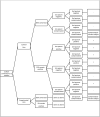Medium matters: modeling the impact of solid medium performance on tuberculosis trial sample size requirements
- PMID: 27084812
- PMCID: PMC4960979
- DOI: 10.5588/ijtld.15.0570
Medium matters: modeling the impact of solid medium performance on tuberculosis trial sample size requirements
Abstract
Setting: Two-month solid medium culture conversion is a commonly used, if suboptimal, endpoint for phase 2 anti-tuberculosis treatment trials.
Objective and design: To model the effect of the performance characteristics (sensitivity and contamination rate) of solid medium on required sample size for a two-arm clinical trial with 85% true (gold standard) culture conversion in the control and 95% in the experimental arm.
Results: Increasing sensitivity and decreasing contamination reduced the sample size from 239 subjects/arm (60% sensitivity, 30% contamination) to 138 subjects/arm (95% sensitivity, 1% contamination).
Conclusion: Optimizing solid medium has significant potential to reduce sample size and increase the efficiency of tuberculosis clinical trials.
Figures


References
-
- Joloba ML, Johnson JL, Feng PI. What is the most reliable solid culture medium for tuberculosis treatment trials. Tuberculosis. 2014;94:311–317. - PubMed
-
- American Thoracic Society (ATS) and CDC Diagnostic standards and classification of tuberculosis in adults and children. Am J Respir Crit Care Med. 2000;161:1376–1395. - PubMed
-
- Regeade F, Picot N, Blanc-Michaud A, et al. Performance of solid and liquid culture media for the detection of Mycobacterium tuberculosis in clinical materials: meta-analysis of recent studies. Eur J Clin Microbiol Infect Dis. 2014;33:867–870. - PubMed
-
- Chihota VN, Grant AD, Fielding K, et al. Liquid vs. solid culture for tuberculosis: performance and cost in a resource-constrained setting. Int J Tuberc Lung Dis. 2010;14:1024–1031. - PubMed
Publication types
MeSH terms
Substances
Grants and funding
LinkOut - more resources
Full Text Sources
Other Literature Sources
Medical

